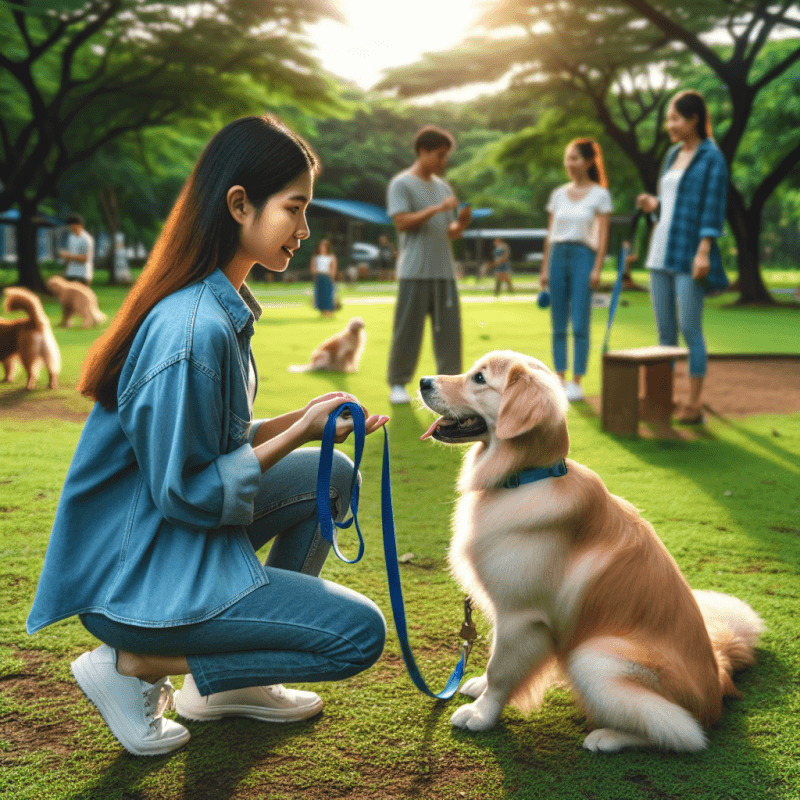Do you ever find yourself wondering why your furry friend behaves the way they do? In the captivating article “Dog Training Human Behavior,” we explore the fascinating connection between dog training and human behavior. Through this unique perspective, you will gain insights into how our own actions and communication styles impact our four-legged companions, and how we can use this knowledge to strengthen the bond we share with them. Get ready to uncover the secrets behind canine behavior and discover effective training techniques that will bring harmony to your relationship with your dog.
Understanding Dog Behavior
Importance of understanding dog behavior
Understanding dog behavior is essential for building a strong and harmonious relationship with your furry companion. By gaining insight into how dogs communicate, interact, and react to different stimuli, you can effectively address behavioral issues, prevent problems, and ensure the well-being of your dog. A solid understanding of dog behavior also allows you to provide appropriate training, socialization, and care tailored to your dog’s individual needs.
Ready for Cat Trivia?
Test your knowledge about cats!

Dog communication signals
Dogs communicate through a variety of signals, both verbal and non-verbal. Understanding these signals is crucial for interpreting and responding appropriately to their needs and emotions. Verbal communication includes barking, growling, and whining, which can indicate anything from excitement to fear or aggression. Non-verbal communication involves body language, such as tail wagging, ear position, and posture. A wagging tail, for example, can indicate happiness, while a tucked tail may suggest fear or anxiety. By recognizing and interpreting these communication signals, you can better understand how your dog is feeling and respond accordingly.
Factors influencing dog behavior
Several factors influence the behavior of dogs, including genetics, past experiences, socialization, and environment. Genetics play a significant role in determining a dog’s temperament and predisposition to certain behaviors. For instance, some breeds are known for their herding instinct, while others are bred for hunting or guarding. Past experiences, such as previous trauma or abuse, can also shape a dog’s behavior. Socialization during the critical early stages of a dog’s life plays a pivotal role in their overall behavior and ability to interact positively with people and other animals. Lastly, the environment in which a dog lives can greatly affect their behavior, including the presence of other animals, noise levels, and the amount of physical and mental stimulation they receive.
Breed-specific behavior traits
Different dog breeds have specific behavior traits that are characteristic to their breed. These traits are a result of selective breeding for certain purposes and can influence a dog’s behavior, temperament, and activity levels. For example, herding breeds such as Border Collies have a strong instinct to chase and control movement, while retrievers like Labrador Retrievers are known for their friendliness and love of water. Understanding breed-specific behavior traits can help you provide appropriate training and enrichment activities to fulfill your dog’s innate needs. It’s essential to research and understand your dog’s breed traits to ensure their overall happiness and well-being.
The Role of Human Behavior in Dog Training
The impact of human behavior on dog training
Human behavior plays a critical role in the effectiveness of dog training. Dogs are highly attuned to human emotions, body language, and cues, which can greatly influence their behavior and responsiveness to training. Positive reinforcement techniques that focus on rewarding desired behaviors are generally more effective in training dogs than punitive or dominance-based methods. The way humans interact, communicate, and behave during training sessions can significantly impact a dog’s willingness to learn and cooperate.
Positive reinforcement techniques
Positive reinforcement techniques are the most effective and humane way to train dogs. These techniques involve rewarding desired behaviors with treats, toys, praise, or other positive stimuli. By focusing on what the dog does right and reinforcing those behaviors, you can encourage and motivate them to repeat those behaviors in the future. Positive reinforcement helps build trust, confidence, and a positive association with training, making it a more enjoyable experience for both the dog and the trainer.
Consistency and patience in training
Consistency and patience are key when it comes to training dogs. Dogs thrive on routine and clear expectations, so it’s important to establish consistent rules and training methods. Consistency allows dogs to understand what is expected of them and helps them feel secure and confident. Patience is crucial as dogs learn at their own pace and may require repetition and reinforcement to grasp new commands or behaviors. Rushing or becoming frustrated can hinder the training process and lead to confusion or anxiety in dogs.
Avoiding punishment and dominance-based methods
Punishment and dominance-based training methods have been proven to be ineffective and potentially harmful to dogs. Using physical force, intimidation, or harsh punishment can erode trust, increase fear or aggression, and damage the bond between the dog and the trainer. Instead, focusing on positive reinforcement, reward-based techniques promotes a cooperative and trusting relationship between you and your dog. By avoiding punishment and dominance-based methods, you can create a safe and positive training environment that nurtures your dog’s mental and emotional well-being.

Socialization and Its Effect on Dog Behavior
Importance of socialization for dogs
Socialization is a crucial aspect of a dog’s development and behavior. It involves exposing your dog to various people, animals, environments, and experiences in a positive and controlled manner. Socialization helps dogs learn how to interact appropriately with others, builds their confidence, and reduces fear or aggression towards unfamiliar stimuli. Proper socialization during the early stages of a dog’s life is vital for preventing behavioral problems later on and fostering a well-adjusted and emotionally balanced dog.
Human interaction and socialization
Human interaction is a fundamental component of socialization for dogs. Exposing your dog to a variety of people, including different ages, genders, ethnicities, and appearances, helps them become comfortable and confident around a diverse range of individuals. Positive experiences with humans build trust and prevent fear or aggression towards people your dog may encounter in everyday life. It’s important to teach children and visitors how to interact appropriately and gently with your dog to maintain positive associations.
Exposing dogs to different environments
Exposing dogs to different environments is vital for socialization and preventing fear or anxiety in unfamiliar settings. Introducing your dog to various outdoor locations, such as parks, beaches, cities, and rural areas, helps them become accustomed to different sights, sounds, and smells. Gradually exposing your dog to new environments and stimuli, while providing positive reinforcement and reassurance, can help reduce fear and increase their confidence when encountering new situations.
Puppy classes and socialization programs
Enrolling your puppy in puppy classes or socialization programs can be highly beneficial in promoting proper socialization. These programs provide controlled environments where puppies can interact with other dogs and people under the guidance and supervision of professional trainers. Puppy classes allow puppies to learn appropriate play behavior, bite inhibition, and basic obedience skills while socializing with their peers. They also provide opportunities for you to learn and practice effective training techniques under the guidance of experts.
Dog Training Techniques
Reward-based training methods
Reward-based training methods, also known as positive reinforcement training, focus on rewarding desired behaviors to encourage their repetition. This method involves using treats, toys, praise, or other positive reinforcements as rewards when your dog exhibits the desired behavior. By associating the behavior with something positive, dogs learn to understand what is expected of them and are motivated to repeat those behaviors. This training technique is effective, humane, and builds a strong bond between you and your dog based on trust and mutual respect.
Clicker training
Clicker training is a specific type of reward-based training that uses a clicker as a marker to signal to the dog that they have performed a desired behavior. The clicker is paired with a treat or reward, creating a positive association with the click sound. The trainer “clicks” when the dog exhibits the desired behavior, followed immediately by a reward. This precise marking helps dogs understand which behaviors are being reinforced, leading to faster and more effective learning.
Target training
Target training involves teaching a dog to touch a specific object, such as a target stick or your hand, with their nose or paw. By associating the target with a reward, you can guide and shape your dog’s behavior. Target training is versatile and can be used for various purposes, including teaching basic commands, guiding dogs into specific positions, or redirecting their attention away from distractions. It also helps improve focus, coordination, and problem-solving skills in dogs.
Crate training
Crate training is a valuable tool for house training and providing a safe haven for dogs. Dogs have a natural instinct to den, and crate training capitalizes on this instinct, providing a comfortable and secure space for them to rest and relax. Crate training involves gradually introducing your dog to their crate, associating it with positive experiences, and using rewards or treats to encourage them to enter and stay in the crate. With consistency and positive reinforcement, crate training can help prevent destructive behavior, separation anxiety, and accidents in the house.
Leash training
Leash training is essential for both the safety of your dog and the enjoyment of walks. It involves teaching your dog to walk calmly and comfortably on a leash without pulling or lunging. Leash training starts by introducing your dog to the leash and collar gradually, using positive reinforcement to create a positive association. Loose leash walking techniques, such as stopping and changing direction when your dog pulls, can help teach your dog to stay by your side. Consistency, patience, and rewards are key to successful leash training.

Effective Communication in Dog Training
Clear verbal commands
Clear verbal commands are essential for effective communication with your dog. Use consistent and concise commands for different behaviors, such as “sit,” “stay,” and “come.” Use a firm but friendly tone and avoid shouting or yelling, as it can confuse or intimidate your dog. Reinforce verbal commands with non-verbal cues, such as hand signals or body language, to enhance communication and ensure clarity.
Body language and hand signals
Body language and hand signals are valuable tools for communicating with dogs, as they are highly attuned to visual cues. Use consistent and distinct hand signals to accompany verbal commands, allowing your dog to understand and respond to your cues even in noisy or distracting environments. For example, raising your hand palm-up can signal “sit,” while extending your arm straight out can signal “stay.” By combining verbal commands with visual cues, you can effectively communicate with your dog and reinforce desired behaviors.
Consistency in communication
Consistency in communication is crucial for training dogs. Use the same commands, cues, and gestures consistently to ensure your dog understands what is expected of them. Inconsistency can lead to confusion and frustration for both you and your dog. Avoid changing commands or using different cues for the same behavior, as it can hinder the learning process. Consistency provides clear boundaries and expectations, helping your dog understand and respond appropriately.
Reinforcing desired behaviors
Reinforcing desired behaviors through praise, treats, or toys is a vital part of effective communication in dog training. Whenever your dog exhibits a desirable behavior, provide immediate positive reinforcement to reinforce that behavior. Praise your dog with enthusiasm, give treats, or engage in play as a reward. This positive reinforcement helps your dog associate the behavior with something enjoyable, motivating them to repeat the behavior in the future. Consistent reinforcement strengthens the learning process and builds a positive relationship between you and your dog.
Understanding Human Body Language to Guide Dog Behavior
The significance of body language in dog training
Body language plays a significant role in how dogs perceive and respond to human interactions. Dogs are highly observant of human body language and can pick up on subtle cues and signals. Understanding and utilizing positive body language can help establish trust, convey intentions, and guide your dog’s behavior effectively.
Positive body gestures and cues
Positive body gestures and cues involve using open and relaxed body language to convey friendliness and approachability. Stand tall and relaxed, avoid crossing your arms or making sudden movements, and maintain eye contact. Offering an open hand for sniffs or gentle scratches can be a welcoming gesture for dogs. Leaning slightly forward can signal engagement and interest, while turning your body away can indicate a friendly non-confrontational posture. Positive body gestures help create a safe and inviting environment for your dog.
Avoiding threatening or intimidating signals
Avoiding threatening or intimidating signals is crucial when interacting with dogs. Dogs are sensitive to signs of aggression or dominance and may respond defensively if they perceive a threat. Avoid direct eye contact, as sustained eye contact can be seen as confrontation. Do not raise your voice, use harsh or forceful gestures, or invade their personal space uninvited. Being mindful of your body language and avoiding threatening signals can help create a calm and safe training environment for your dog.
Reading and responding to canine body language
Understanding and responding to canine body language is essential for effective training and communication. Dogs use various body signals to communicate their emotions and intentions. Pay attention to ear position, tail movement, facial expressions, and overall body posture. A relaxed tail wag, loose body posture, and a soft expression generally indicate relaxation and friendliness. Conversely, a tucked tail, raised hackles, or a stiff body can be signs of fear, anxiety, or aggression. By reading and responding appropriately to your dog’s body language, you can address their needs, prevent misunderstandings, and build trust and rapport.

Dealing with Behavioral Issues in Dogs
Common behavioral problems in dogs
Behavioral problems in dogs can range from mild to severe and may include issues such as excessive barking, aggression, separation anxiety, fear, and destructive behavior. These problems can stem from various underlying causes, including fear, lack of socialization, trauma, or medical issues. Recognizing and addressing these problems early on is crucial to prevent them from escalating and to ensure the well-being of both the dog and the owner.
Identifying underlying causes
Identifying the underlying causes of behavioral problems is essential for effective intervention. Some behavioral issues may result from fear or anxiety, while others may stem from past trauma or lack of proper socialization. Medical conditions or pain can also manifest as behavioral problems. By observing your dog’s behavior, consulting with a professional trainer or veterinarian, and ruling out underlying medical issues, you can gain a better understanding of the cause and tailor your approach to address the specific problem.
Seeking professional help
In cases of severe or complex behavioral issues, seeking professional help from a certified dog trainer or animal behaviorist is recommended. These professionals have extensive knowledge and experience in dealing with a wide range of behavioral problems and can develop a tailored training and behavior modification plan for your dog. Professional guidance provides valuable insights, techniques, and support to address underlying issues and improve your dog’s behavior effectively.
Modifying human behavior to address dog behavior issues
Modifying human behavior is often an essential component of addressing dog behavior issues. Dogs are highly attuned to human emotions and reactions, and they can pick up on subtle cues. If a dog’s behavior is influenced by certain actions or responses from their owner, it’s crucial to modify those actions to address the problem. For example, if a dog becomes anxious or fearful when left alone, gradually desensitizing them to being alone and avoiding reinforcing the anxiety through excessive reassurance can help improve their behavior. Modifying human behavior in conjunction with appropriate training techniques can have a positive impact on resolving behavioral problems.
Creating a Positive Training Environment
Establishing a routine
Establishing a routine is vital for creating a positive training environment. Dogs thrive on consistency and predictability. Set a regular schedule for meals, potty breaks, walks, and training sessions. A consistent routine helps your dog understand what is expected of them and provides a sense of security. It also allows you to maintain a structured training program and ensure regular mental and physical stimulation for your dog.
Creating a designated training area
Creating a designated training area provides a focused and distraction-free environment for training sessions. Choose a quiet and well-lit area in your home or an enclosed outdoor space where you can minimize distractions. Having a dedicated training area helps your dog associate that space with learning and provides a consistent environment for training exercises.
Eliminating distractions
Eliminating distractions during training sessions is crucial for effective learning. Minimize noise, other pets, and visual stimuli that may divert your dog’s attention during training. Start with basic commands in a quiet environment and gradually introduce distractions once your dog has mastered the basics. Building up their ability to focus amidst distractions helps strengthen their training and prepares them for real-life situations.
Setting realistic goals
Setting realistic goals is important to maintain motivation and ensure success in training. Break down larger behaviors or commands into smaller, achievable steps. Celebrate each small milestone and gradually increase the level of difficulty. Setting realistic goals ensures that both you and your dog experience a sense of accomplishment and progress, further enhancing the positive training environment.

Building a Strong Bond with Your Dog through Training
The importance of bonding through training
Training provides an excellent opportunity to build a strong and trusting bond with your dog. By engaging in positive and consistent training sessions, you establish a mutual understanding, respect, and cooperation. Training sessions foster communication, teamwork, and shared experiences, strengthening the bond between you and your dog.
Spending quality time with your dog
Training offers valuable quality time that you can spend with your dog. It enables you to focus solely on your dog’s needs, preferences, and abilities. As you work together towards common goals, you develop a deeper connection and create lasting memories. Regular training sessions also provide mental and physical stimulation, promoting overall well-being for your dog.
Learning to understand and meet your dog’s needs
Through training, you learn to understand and meet your dog’s physical, mental, and emotional needs more effectively. You develop a deeper insight into their preferences, limitations, and motivations, allowing you to tailor their training and care to suit them better. By meeting their needs, you can create a fulfilling and balanced life for your dog and strengthen your bond.
Developing trust and mutual respect
Training encourages trust and mutual respect between you and your dog. Positive reinforcement and clear communication help establish trust and build confidence in your dog. By consistently rewarding desired behaviors and listening to their needs, you develop a relationship based on trust and respect. This trust forms the foundation for successful training and a strong bond that lasts a lifetime.
Continuing Education in Dog Training
Furthering your knowledge on dog behavior and training techniques
Continuing education in dog behavior and training techniques is essential for staying up-to-date with the latest research and developments in the field. There are various resources available, including books, online courses, videos, and workshops, that can expand your knowledge and understanding. By continuously learning, you can refine your training methods, address new challenges, and ensure the best possible care for your dog.
Participating in workshops and seminars
Participating in workshops and seminars is a great way to enhance your dog training skills and gain hands-on experience. These events often feature renowned trainers, behaviorists, and experts who offer valuable insights and practical techniques. Workshops and seminars provide opportunities to learn new training methods, problem-solving strategies, and engage with like-minded individuals who share a passion for training dogs.
Joining professional organizations or groups
Joining professional organizations or groups dedicated to dog training and behavior can open doors to networking and mentorship opportunities. These organizations often provide access to resources, forums for discussion, and ongoing education through conferences or webinars. Connecting with other professionals and enthusiasts in the field allows for knowledge-sharing and staying informed about advancements in dog training.
Keeping up with the latest research and developments
Staying informed about the latest research and developments in dog behavior and training is essential for providing optimal care for your dog. Follow reputable sources, such as scientific journals, reputable websites, and publications by experts in the field. By staying updated, you can incorporate evidence-based practices into your training methods, ensuring the highest standards of care for your four-legged friend.
In conclusion, understanding dog behavior is crucial for building a strong bond and effectively training your furry companion. By recognizing dog communication signals, acknowledging the factors influencing their behavior, and utilizing positive reinforcement techniques, you can create a positive training environment and address behavioral issues. Socialization, clear communication, and reading and responding to body language further enhance the training experience, while addressing underlying causes and seeking professional help can resolve complex behavioral problems. By continuing to learn and staying informed about the latest research and developments, you can provide the best care and training for your dog, forging a lifelong partnership based on trust, understanding, and mutual respect.



